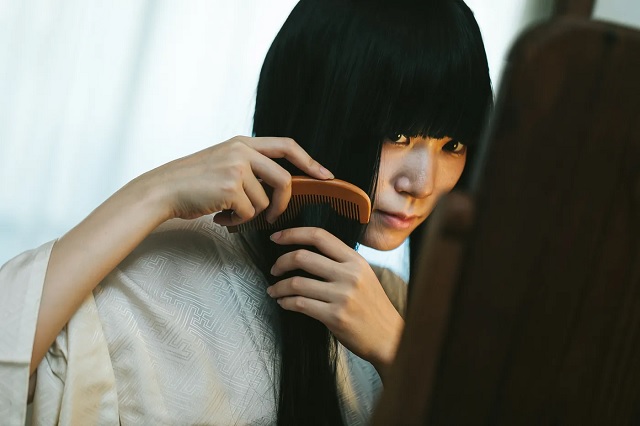
And the vast majority want to look good when they go to see them.
Like all languages, Japanese is constantly evolving, and one word that’s taken on a new meaning in recent years is oshi. Originally the noun-form of the verb osu, or “support,” it’s been adopted in fan culture to mean a celebrity or character that one feels a singularly strong devotion to, such as a favorite idol singer, voice actor or anime star.
Developing that sort of crush on a person you’ve never met, or a character who isn’t actually real, might seem like the exclusive proclivity of male otaku, but there’s no shortage of women with an oshi as well. To gauge just how many, Japanese marketing research firm Cross Marketing surveyed 500 women between the ages of 20 and 49, and found that nearly half, 46.6 percent, have an oshi.
Part of having an oshi is engaging in oshikatsu, or “oshi activities,” such as going to concerts, meet-and-greets, and other fan events. When asked about their preparations for oshikatsu events, the vast majority of women with an oshi, 81.8 percent, say they make an extra effort to look their best before their arrive, with their specific ways of dolling themselves up listed below:
Before going to an oshikatsu event, I:
● Use skincare products: 79.5 percent of respondents with an oshi
● Go on a diet: 65.8 percent
● Make sure my hair is done nicely: 59 percent
● Make sure my nails are done nicely: 43.6 percent
● Make sure my legs look nice (with special massages or by wearing compression socks): 27.4 percent
● Other: 5.1 percent▼ Gotta do that oshikatsu pre-gaming.
Of course, with the pandemic still going on, the number of oshikatsu events are way down, and those that are happening are much smaller in scale. The respondents are hoping things get back to normal soon, though. Out of the 500 women polled, when asked, in general, what they want to do once the pandemic ends, 16.8 percent say they’re looking forward to being able to see their oshi at event venues again, which was more women who said they’re looking forward to visiting their hometowns and seeing their parents (15.2 percent). Considering that those numbers are for the full field of respondents, not just the women who have an oshi, the pull of an oshi’s allure looks to be especially strong for those who’ve found one.
Source: PR Times
Top image: Pakutaso (edited by SoraNews24)
Insert image: Pakutaso
● Want to hear about SoraNews24’s latest articles as soon as they’re published? Follow us on Facebook and Twitter!
[ Read in Japanese ]


 Do Japanese superfans really want to marry their favorite idol?【Survey】
Do Japanese superfans really want to marry their favorite idol?【Survey】 Supporting anime/idol crush tops Japanese teen girls’ New Year’s cash spending targets【Survey】
Supporting anime/idol crush tops Japanese teen girls’ New Year’s cash spending targets【Survey】 Japanese otaku now have special trash box just for merch of their former anime and idol crushes
Japanese otaku now have special trash box just for merch of their former anime and idol crushes For the working otaku – Convertible bags you can take to work and anime/idol events【Photos】
For the working otaku – Convertible bags you can take to work and anime/idol events【Photos】 Japanese company allows workers to take vacation to grieve if favorite idol singer gets married
Japanese company allows workers to take vacation to grieve if favorite idol singer gets married Private booths are coming to Japan’s Shinkansen bullet trains even sooner than we’d thought【Video】
Private booths are coming to Japan’s Shinkansen bullet trains even sooner than we’d thought【Video】 Top Japanese cosplayer Enako returns to Comiket after 6 years, creates mayhem with admirers
Top Japanese cosplayer Enako returns to Comiket after 6 years, creates mayhem with admirers Japanese survey reveals the top 10 most popular ice creams in Japan
Japanese survey reveals the top 10 most popular ice creams in Japan Cosplay costume room tour by Japan’s number-one cosplayer Enako is an eye-opener【Video】
Cosplay costume room tour by Japan’s number-one cosplayer Enako is an eye-opener【Video】 Energy Milk from Japan is the new way to power up your day
Energy Milk from Japan is the new way to power up your day A diner’s guide to oden: Japan’s weird-looking, super-popular winter dish
A diner’s guide to oden: Japan’s weird-looking, super-popular winter dish The Purple Lucky Bag from Village Vanguard is an extra-large waste of money
The Purple Lucky Bag from Village Vanguard is an extra-large waste of money More than one in three Japanese working women in survey would rather be housewives
More than one in three Japanese working women in survey would rather be housewives Osaka to Fukuoka for less than 40 bucks? It’s possible with Japan’s overnight ferry
Osaka to Fukuoka for less than 40 bucks? It’s possible with Japan’s overnight ferry Japanese beef bowl chain Sukiya’s 2026 Smile Box lucky bag basically pays for itself
Japanese beef bowl chain Sukiya’s 2026 Smile Box lucky bag basically pays for itself Starbucks Japan ready to get Year of the Horse started with adorable drinkware and plushies【Pics】
Starbucks Japan ready to get Year of the Horse started with adorable drinkware and plushies【Pics】 Hayao Miyazaki says Happy New Year to Studio Ghibli fans with new art for Year of the Horse
Hayao Miyazaki says Happy New Year to Studio Ghibli fans with new art for Year of the Horse We found possibly the quietest Japanese-style hotel in Tokyo’s bustling Shinjuku district
We found possibly the quietest Japanese-style hotel in Tokyo’s bustling Shinjuku district Cup Noodle tries an authentic Jiro-style ramen, but something’s not quite right
Cup Noodle tries an authentic Jiro-style ramen, but something’s not quite right The best Starbucks Japan Frappuccinos we want to drink again in 2026
The best Starbucks Japan Frappuccinos we want to drink again in 2026 We revisited Sweets Paradise after a decade to see if Japan’s dessert buffet still delivers
We revisited Sweets Paradise after a decade to see if Japan’s dessert buffet still delivers That time Seiji called JASRAC to ask why he didn’t get paid royalties for his song being on TV
That time Seiji called JASRAC to ask why he didn’t get paid royalties for his song being on TV Japan’s oldest largetooth sawfish in captivity back on display in Mie Prefecture
Japan’s oldest largetooth sawfish in captivity back on display in Mie Prefecture Pizza Hut Japan’s hot lucky bags are perfect for a New Year’s pizza party
Pizza Hut Japan’s hot lucky bags are perfect for a New Year’s pizza party 7-Eleven Japan starts new temporary luggage storage service in over 300 branches
7-Eleven Japan starts new temporary luggage storage service in over 300 branches Disillusionment at Tsukiji’s tourist-target prices led us to a great ramen restaurant in Tokyo
Disillusionment at Tsukiji’s tourist-target prices led us to a great ramen restaurant in Tokyo Starbucks teams up with 166-year-old Kyoto doll maker for Year of the Horse decorations【Photos】
Starbucks teams up with 166-year-old Kyoto doll maker for Year of the Horse decorations【Photos】 Tokyo considering law requiring more trash cans following litter increase in heavily touristed area
Tokyo considering law requiring more trash cans following litter increase in heavily touristed area Tokyo’s Tsukiji sushi neighborhood asks tour groups to stay away for the rest of the month
Tokyo’s Tsukiji sushi neighborhood asks tour groups to stay away for the rest of the month Tokyo event lets you travel back in time, for free, to celebrate 100 years since Showa era start
Tokyo event lets you travel back in time, for free, to celebrate 100 years since Showa era start Japan may add Japanese language proficiency, lifestyle classes to permanent foreign resident requirements
Japan may add Japanese language proficiency, lifestyle classes to permanent foreign resident requirements Sanrio theme park in Japan announces plans to expand into a Sanrio resort
Sanrio theme park in Japan announces plans to expand into a Sanrio resort Stamina-destroying “Paralysis Noodles” are Tokyo’s newest over-the-top ramen innovation
Stamina-destroying “Paralysis Noodles” are Tokyo’s newest over-the-top ramen innovation Survey asks foreign tourists what bothered them in Japan, more than half gave same answer
Survey asks foreign tourists what bothered them in Japan, more than half gave same answer Japan’s human washing machines will go on sale to general public, demos to be held in Tokyo
Japan’s human washing machines will go on sale to general public, demos to be held in Tokyo Japan’s deadliest food claims more victims, but why do people keep eating it for New Year’s?
Japan’s deadliest food claims more victims, but why do people keep eating it for New Year’s? We deeply regret going into this tunnel on our walk in the mountains of Japan
We deeply regret going into this tunnel on our walk in the mountains of Japan Studio Ghibli releases Kodama forest spirits from Princess Mononoke to light up your home
Studio Ghibli releases Kodama forest spirits from Princess Mononoke to light up your home Major Japanese hotel chain says reservations via overseas booking sites may not be valid
Major Japanese hotel chain says reservations via overseas booking sites may not be valid Put sesame oil in your coffee? Japanese maker says it’s the best way to start your day【Taste test】
Put sesame oil in your coffee? Japanese maker says it’s the best way to start your day【Taste test】 No more using real katana for tourism activities, Japan’s National Police Agency says
No more using real katana for tourism activities, Japan’s National Police Agency says Starbucks Japan reveals new sakura drinkware collection, inspired by evening cherry blossoms
Starbucks Japan reveals new sakura drinkware collection, inspired by evening cherry blossoms Updated cherry blossom forecast shows extra-long sakura season for Japan this year
Updated cherry blossom forecast shows extra-long sakura season for Japan this year Anime vs. idols? Latest annual otaku survey shows where fans are spending their money
Anime vs. idols? Latest annual otaku survey shows where fans are spending their money Nearly 70 percent of young Japanese women self-identify as otaku in survey
Nearly 70 percent of young Japanese women self-identify as otaku in survey Japan’s biggest K-pop fans might just be senior citizens, survey shows
Japan’s biggest K-pop fans might just be senior citizens, survey shows Nearly half of young Japanese women say they “hate” the company they work for in survey
Nearly half of young Japanese women say they “hate” the company they work for in survey How do young Japanese women spend their hard-earned money to treat themselves?
How do young Japanese women spend their hard-earned money to treat themselves? Nearly half of young Japanese men in survey have never had a girlfriend, zero-boyfriend women rise too
Nearly half of young Japanese men in survey have never had a girlfriend, zero-boyfriend women rise too Japanese women reveal their ideal kiss scenarios【Survey】
Japanese women reveal their ideal kiss scenarios【Survey】 Idol singer dating bans are unnecessary, say majority of Japanese college men in survey
Idol singer dating bans are unnecessary, say majority of Japanese college men in survey Roughly 40 percent of single Japanese men in their 20s have never been on a date, survey says
Roughly 40 percent of single Japanese men in their 20s have never been on a date, survey says Survey picks “thin” as second-least-attractive body type for Japanese women
Survey picks “thin” as second-least-attractive body type for Japanese women Survey claims that 30 percent of boys’ love fans in Japan are men
Survey claims that 30 percent of boys’ love fans in Japan are men How do Japanese women feel about going Dutch on a date? Survey investigates, finds gap
How do Japanese women feel about going Dutch on a date? Survey investigates, finds gap Young Japanese women like alcohol more than any other age group, almost as much as old men【Survey】
Young Japanese women like alcohol more than any other age group, almost as much as old men【Survey】 Japanese women show overwhelming resistance to unisex bathrooms in survey
Japanese women show overwhelming resistance to unisex bathrooms in survey Japanese husbands in survey say they do half the housework and childcare, wives say “Nope!”
Japanese husbands in survey say they do half the housework and childcare, wives say “Nope!” Survey shows more Japanese married men, single Japanese women cheating on their romantic partners
Survey shows more Japanese married men, single Japanese women cheating on their romantic partners Japanese women show continuing decline in how much they expect a husband to earn in survey
Japanese women show continuing decline in how much they expect a husband to earn in survey
Leave a Reply